In the 1700s, they were called Mustees or Black Creeks. George Gist (Sequoyah) was actually the son of a Mustee mother (slave) from South Carolina and an Ashkenazi Jewish father (trader), but considered himself Cherokee. The Black Seminoles became the original Buffalo Soldiers. Coretta Scott King was another famous Mustee. Her Alabama family considered themselves Creek, until she married the Rev. Martin Luther King. Mustee families were also some of the original settlers of the Native American community, where my grandmother grew up, Ruckers Bottom, on the Savannah River in Georgia.

PART SIX
by Richard L. Thornton, Architect and City Planner
While studying the then hidden story of Native American slavery, Florida anthropologist John Worth came to the conclusion that at least 600,000 indigenous people in Southeastern North America had been abducted into slavery. Slave raiders typically only took with them young women and teenagers. The men, defending their families, were killed by European slave raiders. The Native tribe slave raiders usually tortured and killed all men of military age, plus butchered the toddlers, who could not make the walk back to coastal slave markets. Thus, at least 600,000 Native Americans died as a result of slave raids.
The big problem with Native American slaves, though, was that unless they were sold to plantations on Caribbean Islands, they often found a way to escape back to Indian tribes within the interior. After King Charles II of England became personally involved in the African slave trade, African slaves became preferred by customers in the British colonies. Almost all of the British colonies (including Georgia after 1752 and Canada after 1763, but excluding Pennsylvania) legalized the slavery of Africans.

The Gullah Peoples of coastal Georgia and South Carolina proudly celebrate their rich multi-cultural heritage. They dress as Creek Indians, fashion savvy Sisters and as Buffalo Soldiers!
Thus, the lives of African slaves and Native Americans became interwoven. Books and newspaper articles were published in the Carolinas, which promoted scientific breeding programs for mixing the two races to create an ideal slaves. These documents are absolutely nauseating to modern eyes, because they present non-European humans as being no different than cattle or horses.
Human slavery had only been a legally sanctioned institution in the North American colonies for 5 years, when the colony of Charles Towne was founded in 1670. John Worth found that by 1710, 20% of South Carolina’s population was Native American slaves and 40% was African slaves. During this period most African slaves had only a minimal knowledge of English. In their isolation on the coastal rice plantations, they evolved a new language that is called Gullah today. It mixed the words of several African languages with words of the Creek Indians and English.
Owners of African slaves, fresh off the ship in New York, Delaware, Maryland and Virginia had quickly discovered that many of these people died during the harsh North American winters. Over the eons they had evolved bodies, which thrived in the hot, humid tropical climate of West Africa, but were very vulnerable to cold temperatures. Those that happened to mate with Indigenous American slaves produced offspring, whose more muscular, heavy boned physiques were much more tolerant to wintertime.
The African slaves were only able to orient themselves to this strange new land by listening to the words of the Native American slaves. The Indigenous and Mustee slaves told of a land to the south called La Florida, where slavery was now illegal.
The boldest slaves found ways to escape their bondage. Some Africans accompanied their Indigenous friends to native towns in the interior, but with that came the risk of being captured by English bounty hunters at any time. For slaves to obtain secure freedom, meant a dangerous walk in bare feet of over 100 miles to the border of La Florida. Along the way were dangerous swamps filled with several species of poisonous snakes and alligators. Most of these freedom-seekers were only dressed in rags and carried little or no food with them.
As early as 1687, African slaves fled from the South Carolina Low Country to Spanish Florida seeking freedom. Despite Spain’s despicable treatment of America’s indigenous peoples in the 1500’s, human slavery had now been banned. Under an edict from Philip V of Spain in 1693, the black fugitives received liberty in exchange for converting to Catholicism and defending the Spanish settlers at St. Augustine for at least four years. However, most of the Black militia was more than happy to be permanently allowed to kill English-speaking invaders.
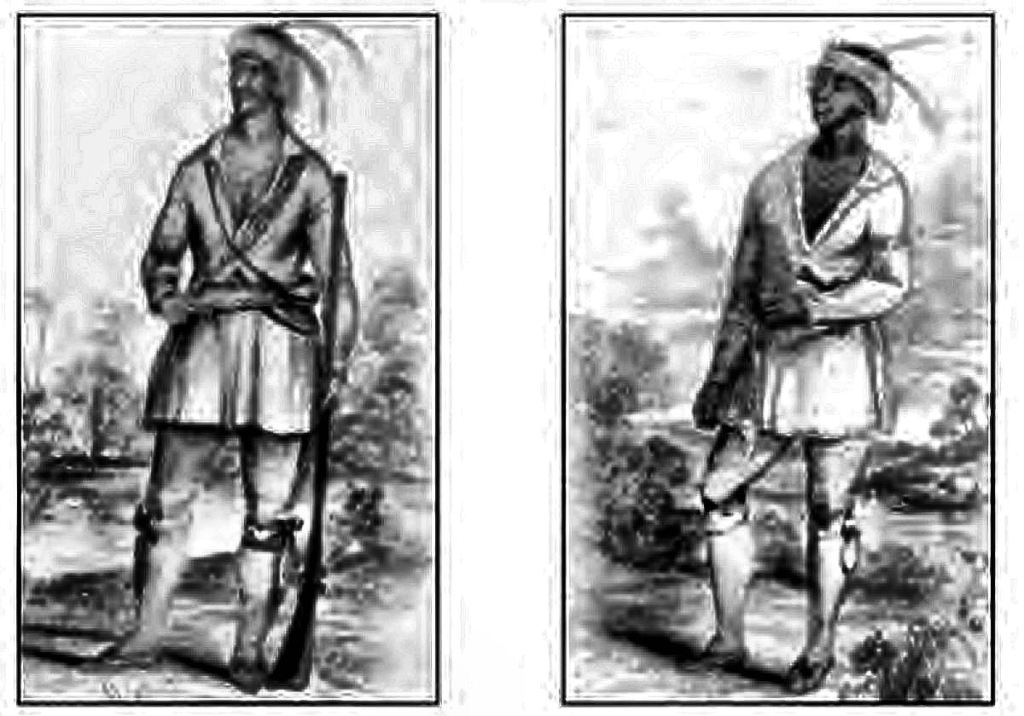
Comparison between Eastern Creek (Georgia) and Black Creek (Florida) warriors
After the Province of Georgia was colonized immediately north of La Florida in 1788, the Spanish organized the Africans into a militia led by a man named Francisco Menendez. He was a Mandingo from Africa, who had escaped a South Carolina plantation in 1724 and risen to the rank of an officer under the flag of Spain. The African militia unit was based at Gracia Real de Santa Teresa de Mose (Royal Thanks of Saint Teresa of the town of Moses.) It came to be known as Fort Mose. A formally planned settlement was founded around in 1738. It was the first legally sanctioned free black town in North America. Contemporary sketches of the fortress suggest that it strongly resembled a fortified Mandingo village, with the addition of Spanish bastions on the corners.
In 1740 Fort Mose was attacked by a English army from Georgia under General James Edward Oglethorpe. The occupants fled to Castillo de San Marcos, but the African militia returned in force to attack the English troops there, killing all but about 30 of them. The fort and settlement was rebuilt in 1752, but abandoned in 1763, when Spain and France lost the Seven Years War, and Great Britain gained ownership of Florida.

Fort Mose around 1740
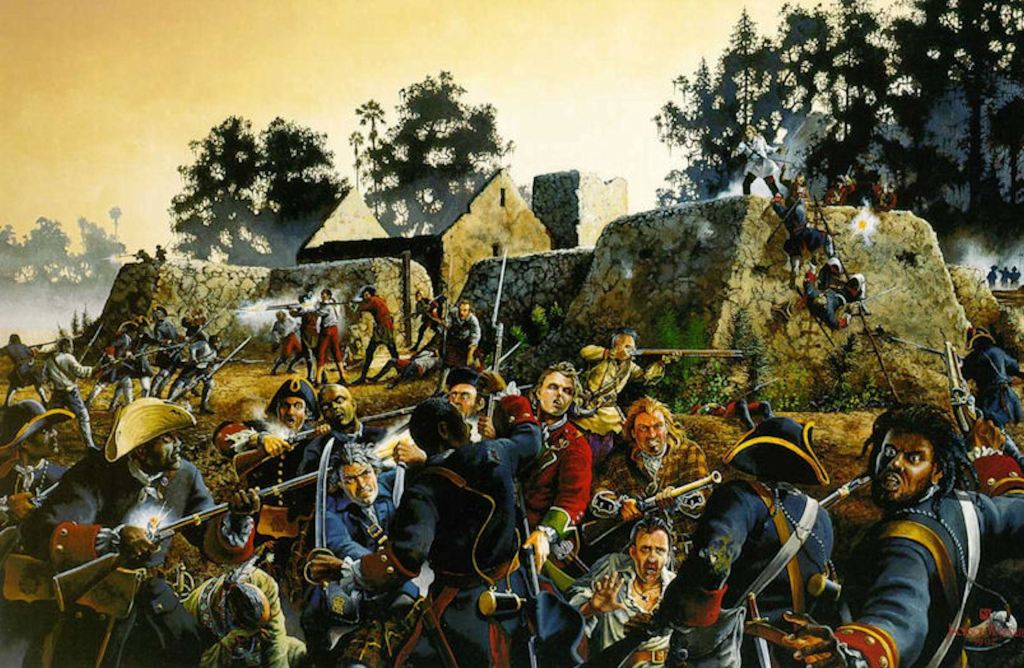
British attack on Fort Mose in 1740
George Gist (Sequoyah) – a Mustee intellectual giant
Upon obtaining a photocopy of the original manuscript of The History of the Cherokee People (1826) by Cherokee Principal Chief Charles Hicks, it quickly became obvious that what is promoted today as the biographies of Sequoyah, Nancy Ward and Tsali are mostly fictional, fairytales.
Sequoyah was the son of Indian trader Nathaniel Gist and his Mustee slave from South Carolina, Wutah. Wutah means “witch or sorceress” in several West African dialects. Their son was born at the Gist trading post in Cherokee town of Tuskegee on the Little Tennessee River.
It was quite common for Indian traders to place Mustee slave women in charge of their trading posts. The women were taught how to read, write and do arithmetic. They enjoyed higher economic status and basically lived as free women. George Gist grew up in Tuskeegee, speaking the Cherokee dialect, spoken at Tuskegee and playing with Cherokee children. It is quite normal for him to think of himself as a Cherokee. During the Cherokee-Chickamauga War, George fought with the hostiles. He discarded his white name and took the alternate name of his mother . . . without knowing its meaning. Sekoya is the Creek word for “slave or war captive.” It is derived from the Creek word for a pig. Cherokees originally could not pronounce a hard K sound and so substituted a Kwa sound.
The syllabary that George created bore no resemblance to the symbols used today, which are called “the Sequoyah Syllabary.” His symbols are identical to either the Late Medieval Script used by Christians in eastern Anatolia and the Caucasus region or else are symbols used by alchemists during the Middle Ages . . . that writing system now being called the Witch’s Alphabet.
Here is where the Mustee George Gist showed his genius. The sounds associated with Medieval Anatolian Script are entirely different than those associated with the same symbols in the Sequoyah Syllabary. Without any assistance from white scholars, he analyzed the spoken Cherokee language and broke it down into those sounds it pronounced. These sounds or syllables were then assigned abstract symbols from an entirely different cultural tradition. This was a task that even today, people with PhD’s in Linguistics would find daunting.

Sequoyah probably never even saw the much different syllabary used today.
The meaning of Wutah’s name is highly significant. In 1821, North Carolina Cherokees kidnapped George Gist and his wife, charging them with witchcraft. They were sentenced to be slowly tortured to death. George was maimed for life and his first wife near death, when they were rescued by the Georgia Cherokee Light Horse Police, commanded by John Ridge, Jr. His first wife may have died later, because she is never mentioned again. Gist headed west to Arkansas.
Hicks and George Gist fought together and were comrades in the Cherokee Chickamauga War. Charles Hicks never mentioned the word, Sequoyah, in his history of the Cherokee People. He did highly praise Georgia Gist. He and the Cherokee National Council issued a silver medal to George Gist in 1825.
However, as soon as Gist had headed back west, Hicks and missionary Samuel Worcester began work on a new syllabary, which is basically the one used today. Worcester continued to make refinements on the writing system, until is death in 1859. This syllabary was called the Hicks Syllabary until the mid-20th century, when George Gist’s life was fictionalized by Southern academicians and Cherokee bureaucrats. The existence of the original syllabary was concealed. I obtained a copy of it from the National Museum of American History. It is not mentioned in the National Museum of the American Indian – both museums being operated by the Smithsonian Institute.
- Nancy Ward was born and grew up in the Nacoochee Valley of Georgia. Until 1795, she lived in Creek-owned territories of Northeast Georgia with her husband, Bryan Ward . . . in Augusta, GA, at Revolutionary War forts on the Tallulah River in Habersham County, near Fort James in Elbert County, GA and on Ward Creek in Stephens County, GA. The DNA of her descendants in Georgia has been analyzed. She was of mixed Southern Mesoamerican and Sephardic Jewish descent. She WAS highly-respected by her White neighbors in Georgia, but as a peacemaker. Her real life is well-documented by Georgia newspapers of that era and The Early History of Franklin County, GA. We will have a separate article on her.
- Tsali’s real name was the Creek first name Tchali. He was a Uchee Indian, living far away from the Cherokee Nation on land that he legally owned in the Dillard Valley of Rabun County, GA. Legally, he was a citizen of the State of Georgia and should not have been molested by US Army soldiers. He was re-captured by a band of Cherokees, led by Junaluska and executed by a Cherokee firing squad, commanded by Junaluska. Junaluska grew up in the Dillard Valley! Hm-m-m! We will also have a separate article on Tchali and Junaluska.
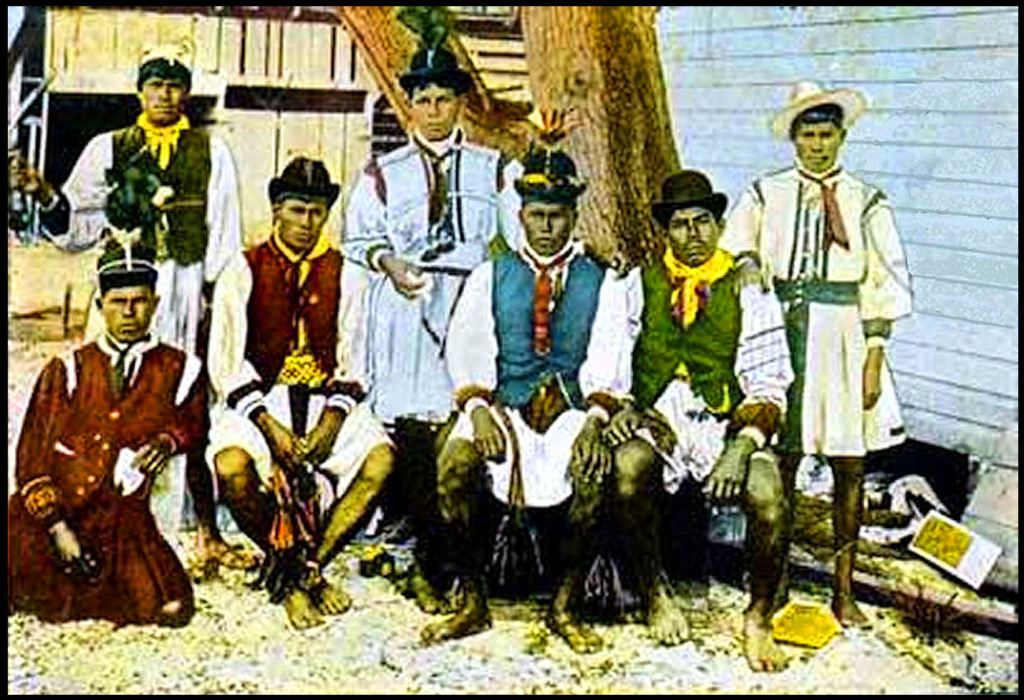
The Black Seminoles
Something very interesting was occurring within the interior of Florida, throughout the 1700s and early 1800s. Villages of Creek Indian farmers drifted into uninhabited parts of Florida during this period. They had little contact with the Spanish authorities in St. Augustine. The Spanish didn’t dare try to evict the Creeks because of their past unpleasant experiences in combating them. The last time the Spanish tried to invade the Creek Nation in 1703, they left behind around 600 bodies lying on the battlefield. The Creeks did not adopt Spanish traditions or religion. These Creeks in Florida eventually became known as Seminoles, because they did not have strong political connections with the Creek provinces to the north. However, even as late as 1776, the Seminoles were merely considered a division of the Creek Confederacy, not a separate tribe. This is how botanist William Bartram described his contacts with the Seminoles in 1776/
Simultaneously, Africans continued to escape from plantations in the southern colonies and sought refuge in Florida. It was much easier for the African slaves to escape farms and plantations along the interior frontier, because there was virtually no law enforcement officers in these regions. Of course, the Creeks had a long history of sedentary living and well-planned towns, but the Africans had been often been treated as little more than livestock by planters. One of the many delusions held by white planters was that Africans were incapable of surviving without the management of white people.
Almost immediately after gaining their freedom, the Africans began establishing orderly, clean villages and planting crops in northern Florida. They developed local governments, modeled after those of the Creeks. However, the absorption of Native American culture went far beyond politics. The Africans switched to wearing Creek clothing. They learned to speak the Itsate-Creek language instead of either English or African. Itsate, not Muskogee, was the predominant language of South Carolina and Georgia Creeks. Itsate is really a dialect of the Itza Maya language, which is also called Itsate.
What is more surprising is that the Black Seminoles adopted the Creek’s ancient monotheistic religion, which was similar to that of the Hebrews before the building of Solomon’s Temple and also, the Samaritan sect today. Unlike some other monotheistic religions, Creek & Black Seminole women were equal to the men in all ways. In fact, the women owned most of the real estate!
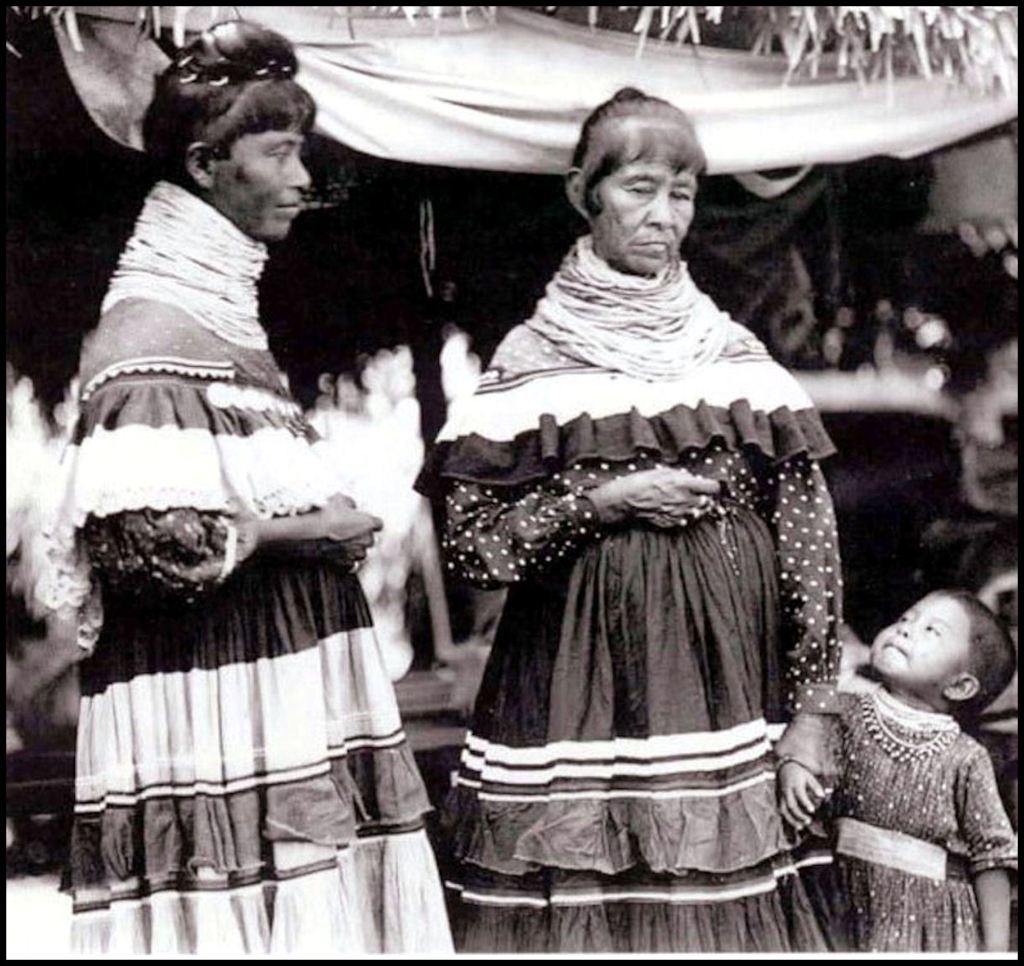
It is said that the Black Seminoles particularly relished the Creek custom of daily ritual bathing, because as slaves they were intentionally kept filthy as a symbol of degradation. Cleanliness was seen as a sign of being free humans.
Since the two ethnic groups were political allies and trading partners, there was some intermarriage between Creeks, Mustees and Africans. Creek tradition and laws forbade marriage to close kin, so both Seminoles and Black Seminoles looked for spouses with different physical features than themselves. This is a primary reason why Eastern Creeks and Black Seminoles do not have the severe problems with inherited diseases such as bipolar behavior, alcoholism or diabetes, which is typical of many Western and Northern tribes. Although a serious health problem among full-blooded Africans, sickle cell anemia is rare among Mustees and Black Seminoles.
Dr. Andrew Frank, a history professor at Florida State University has studied the available archives on Black Seminoles. He has determined that in general, the Creek Seminoles and the Black Seminoles lived in separate communities and maintained separate political organizations. The Creek Seminoles treated the Black Seminoles as if they were merely another division of the diverse Creek Confederacy. Some Creek Seminoles “owned” African slaves, but these slaves could do as they pleased as long as they provided annual tributes (goods) to their owners. It was a different concept of slavery than in the U.S.

Under the conditions of liberty in Florida, the Black Seminoles flourished. U.S. Army Lieutenant George McCall recorded his impressions of a Black Seminole community in 1826:
We found these negroes in possession of large fields of the finest land, producing large crops of corn, beans, melons, pumpkins, and other esculent vegetables. [I] saw, while riding along the borders of the ponds, fine rice growing; and in the village large corn-cribs were filled, while the houses were larger and more comfortable than those of the Indians themselves.”
The Seminoles and Black Seminoles were military allies throughout the bloody Seminole Wars. These wars also drew the support of slaves in Alabama and Georgia. The Black Seminoles and Spanish-speaking mixed-blood Creeks from the North Georgia Mountains generally operated as cavalry units or “mounted rifles,” while the Muskogee-Creeks were infantry.
The U.S. government feared that the Free Black and Creek cavalrymen would turn the Seminole War into a widespread slave rebellion. That alliance ended in 1838 when the United States offered to recognize the freedom of the Black Seminoles and pay them money, if they would lay down their arms and agree to move to the Indian Territory. Over 500 Black Seminoles took up the offer.
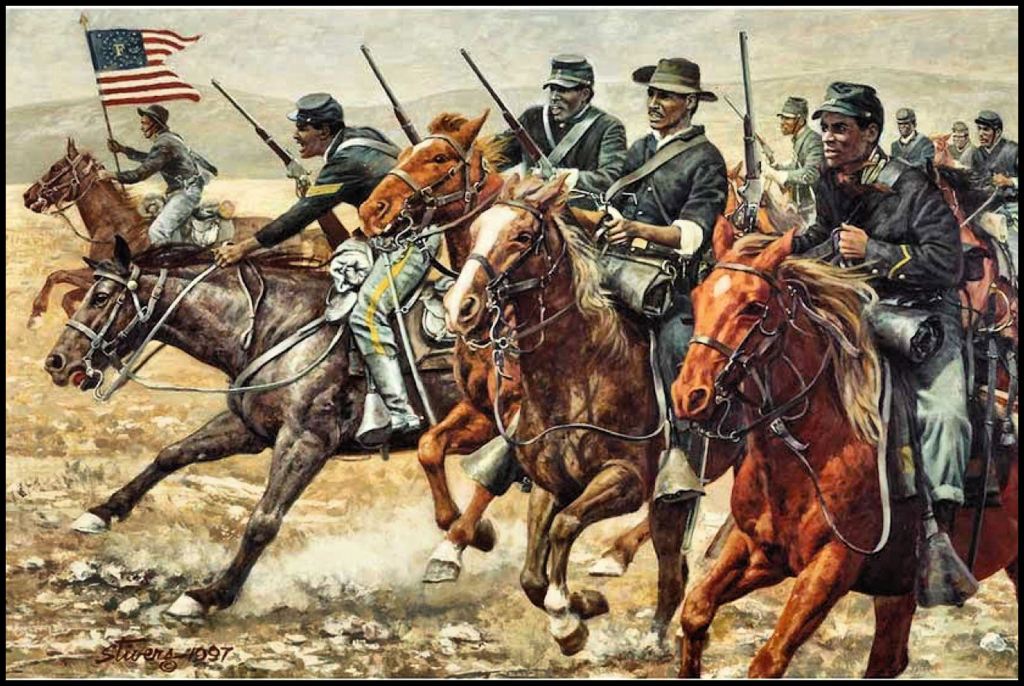
Once in the west, many Black Seminoles adapted to the lifestyle of the plains. Most were already expert horsemen. Some became cowboys. Many Black Seminoles accepted an offer from Mexico to form a border patrol to combat Comanche and Apache raiders. At the end of the Civil War the Black Seminoles were invited to return to the United States to serve in a “special ops” unit to combat hostile tribes and enforce martial law in the South during Reconstruction. Those that accepted, were promised land and retirement pensions at the end of their service.
This forerunner of the Green Berets or Navy SEALs quickly developed the reputation as the finest military unit in the West. It was soon expanded into being the Seminole-Negro scout troop of the new 10th Calvary Regiment. Although the Black Seminoles became known as the best scouts in the best cavalry regiment in the West AND won four Medals of Honor, very few ever received land or a pension. When it came time for them to retire, U.S. government officials said that it had lost the original treaty and had no record of them serving in the U.S. Army. Even Medal of Honor winners did not get pensions!

Black Seminole descendants still live in Florida, rural communities in Oklahoma and Texas, in the Bahamas and Northern Mexico. In the 19th century, the Florida “Black Seminoles” were called “Seminole Negroes” by their white American enemies and Este-lusti, or “Black People,” by their Creek Indian allies. Modern Black Seminoles are known as “Seminole Freedmen” in Oklahoma, “Seminole Scouts” in Texas, “Black Indians” in the Bahamas, and “Mascogos” in Mexico.
Well . . . but here in Dixie, we Eastern Creeks just call them . . . heroes.

Reblogged this on Ritaroberts's Blog.
LikeLiked by 1 person
Your work gets better and better. !
Cherokee had a sacred writing that was very difficult to learn. Boys spent weeks with ktana’i and other priests learning it. Robert J. Conley put legends into novels, and is famous that he stuck to the original story. After the breakup of the Iroquois horde, the ani Cherokee fled south taking all books and many priests with them. They wound up forced to settle in the mountains. Nana, Granny, said that’s what happened, not that any of hers were sacred people LOL. Even today, Cherokee take witchcraft very seriously. But, I never heard of anyone being tortured for it, lt alone a Jew. The ax, yes.
Traditional ‘slavery’ among American Indians was like that of the Hebrews, and was one reason Columbus claimed we were the 10 Lost Tribes. For that matter, why the hell is Columbus so hated? He was nearly killed for defending American Indians and upholding Catholic church law, that American Indians were not to be harassed unless breaking Spanish law. He continued his work till found innocent of treason and went to Santo Domingo with his Taino wife and children. Unless forced to, he never did anything to harm American Indians.
LikeLiked by 1 person
The Kingdom of Apalache, which was the forerunner of the Creek Confederacy forbade slavery, human sacrifice, animal sacrifice and witchcraft. A group of English settlers were planning to move there in 1653 from Barbados, but backed out and instead moved to Virginia, because the King of Apalache would not let them keep their African and Native American slaves. Only a few wealthy, mixed blood Cherokees ever owned African slaves.
LikeLiked by 2 people
Yes, some Cherokee claimed to own their slaves, but for the most part, they were family, usually adopted into, often marrying into the family. A gvnaki, black American Indian, told me that when full bloods stopped the traditions for fear of Carlyle, it was the blacks who kept the language and all for the future.
All Western slavery is based on debt. Very often Hebrews in bondage were adopted, and women usually married into the owner’s family. When a slave was freed, he was given all pay he would have earned as a free man. One reason Jesus used the whip was because the wealthy wanted to go European. In Europe, slavery was for life and usually a very short life, at that. But, we can see what happened to Cherokee over the issue of slavery. For some, the War Between the States never ended. niio
LikeLiked by 1 person
Lucy Guevara, a Taino from Cuba, asked me to post this comment. Please put the following in a reply that was made by one of your readers regarding Columbus on the comments by Tsali. It would not allow me to comment again. It was made on what you shared last . I would stay quiet and not respond if it were on another subject but this is something I won’t stay silent about. With all respect on the comment of Christopher Columbus. I cringe when I hear his name. He is that eras Adolf Hitler. He was no hero and someone that caused tremendous pain and torture to the indigenous people he encountered, all while using his Catholicism as an excuse. If he were a true believer he would have not committed the atrocities he and his men committed. He tried to find justification in taking lands and killing people using his faith but what they did went completely against their Faith. He is no hero, he does not deserve to be remembered or celebrated. In the Caribbean atrocities were committed against the natives to instill fear and subdue the people. A different tactic was used initially with the U.S. natives for the following reason not because Columbus decided to be a good Catholic with them but because it was to his advantage to have them on their side when other countries as France and Britain were raising here to claim this land also. He used a different tactic here. There were too many tribes, too great a number of people to subdue and the challenge of fighting off the French and British counterparts. So instead of wreaking havoc like was done in the Caribbean islands he used the people here he encountered to his advantage. The havoc and killings would come later as a result of them setting foot on Turtle Island. He had no right to do what was done and take what he took. This goes also for the countries that followed in his footsteps and paid for all these expeditions. What’s done is done, that doesn’t mean I or others should see him as a hero or great explorer, he was a murderer, thief and rapist.
https://www.greatfallstribune.com/story/news/2021/10/11/8-myths-and-atrocities-christopher-columbus-and-columbus-day/6092483001/
LikeLike